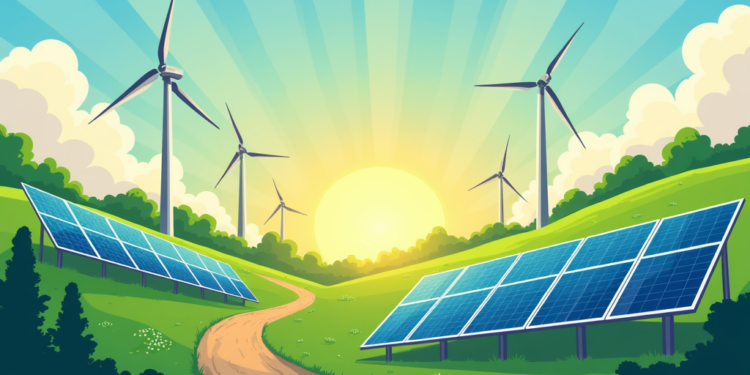Renewable energy is rapidly transforming the U.S. energy sector, marking a significant shift towards a cleaner, more sustainable future. As of 2022, renewable energy sources, including solar and wind power, contributed about 20% of the total electricity generation, reflecting a remarkable 10-year growth trajectory. This shift is not merely a trend; it represents a vital component of the energy transition aimed at establishing a clean energy economy. With increasing investments and advancements in technology, the potential for renewable energy growth is immense, providing both environmental and economic benefits. The Biden administration’s commitment to reducing greenhouse gas emissions by 50% by 2030 further underscores the urgency and importance of embracing renewable energy solutions.
The landscape of sustainable power is increasingly being shaped by alternative energy sources, commonly referred to as green energy or clean technology. This evolution includes robust sectors such as solar and wind energy, which are spearheading the transformation of the U.S. energy economy. As the nation shifts towards a more eco-friendly and sustainable energy framework, the focus on harnessing natural resources is paramount. The energy transition is not just a buzzword; it encapsulates a broader movement towards utilizing renewable resources for electricity generation, thereby driving significant change within the American power grid. This growing emphasis on alternative energy solutions not only helps combat climate change but also fosters economic growth and job creation in emerging sectors.
The Growth of Renewable Energy in the U.S. Power Sector
The growth of renewable energy within the U.S. power sector has been remarkable over the last decade. In 2022, renewable sources accounted for approximately 20% of total electricity generation, showcasing a significant leap from previous years. This increase can be attributed to various factors, including technological innovations that have made renewable energy solutions more efficient and cost-effective. For instance, advancements in solar panel technology and wind turbine design have drastically reduced installation and maintenance costs, enabling broader accessibility to renewable solutions across diverse regions.
Moreover, the rise in renewable energy capacity has been further bolstered by state-level initiatives and federal policies aimed at promoting clean energy adoption. With states like California and Texas leading the charge, investments in renewable infrastructure, such as solar farms and wind plants, are proliferating. This surge not only contributes to national energy independence but also aligns with global efforts to combat climate change, highlighting the U.S.’s crucial role in the renewable energy landscape.
Solar and Wind Power: The Cornerstones of Renewable Energy
Solar and wind power stand out as the two primary sources driving the renewable energy surge in the United States. Solar energy, in particular, has seen an explosive rise due to falling costs and increasing efficiency. More households and businesses are adopting solar technology, often supported by federal tax incentives and state subsidies that make transitioning to solar more financially feasible. As a result, solar installations have proliferated, especially in states with abundant sunlight and supportive policies.
Wind power, on the other hand, has established itself as a significant contributor to the U.S. energy mix, particularly in areas prone to high wind speeds such as the Great Plains and Texas. The implementation of advanced turbine technologies has enhanced energy capture, proving that wind installations can reliably provide electricity to millions of homes. This dual focus on solar and wind energy not only paves the way for a cleaner energy landscape but also contributes to establishing a robust and resilient clean energy economy.
The Role of Government in Advancing Renewable Technologies
The federal government plays a critical role in the advancement of renewable energy technologies in the United States. Through various initiatives, including tax credits, grants, and substantial funding for research and development, the government has stimulated the growth of the renewable sector. These financial incentives encourage both consumers and businesses to consider renewable solutions, making them more accessible and appealing. As policies evolve with administrations, the emphasis on a clean energy transition has become increasingly prominent, as reflected in the ambitious goals set forth by the current administration.
Additionally, government support is instrumental in fostering partnerships between public and private sectors, which is essential for driving innovation and investment in clean energy technologies. This collaborative approach not only aids in overcoming existing barriers but also ensures that the U.S. energy sector is prepared to meet future demands for clean energy, paving the way for a sustainable energy future.
Challenges in the Energy Transition to Renewable Sources
Despite the encouraging strides made in the renewable energy sector, several challenges must be addressed to ensure a successful energy transition. One of the primary obstacles is the underdevelopment of energy storage infrastructure. Given the intermittent nature of solar and wind power—where generation does not always align with demand—efficient energy storage solutions are crucial. Without advanced battery technologies or alternative storage methods, harnessing and utilizing renewable energy remains a complex issue.
Furthermore, regulatory and logistical challenges also pose hurdles for large-scale renewable energy projects. Zoning laws, environmental regulations, and the need for grid enhancements can slow down progress and add complexities to project implementation. Addressing these challenges will be essential for the U.S. to fully capitalize on its renewable energy potential and drive sustainable development.
Economic Benefits of Investing in Renewable Energy
Investing in renewable energy has profound economic benefits for the U.S. economy. As the sector expands, job creation becomes a natural byproduct. Numerous jobs are being generated in manufacturing, installation, and maintenance of renewable systems, equipping workers with skills necessary for the evolving job market. Furthermore, as clean energy sources like wind and solar become more prevalent, they also bolster local economies through increased investments and infrastructure development.
Additionally, embracing renewable energy contributes to energy independence, reducing reliance on imported fossil fuels. This shift not only enhances national security but also stabilizes energy prices against the volatility of global oil and gas markets. By investing in renewable technologies, the U.S. positions itself not only for economic growth but also for environmental sustainability, ensuring a cleaner and healthier future for generations to come.
The Impact of the Biden Administration’s Clean Energy Policies
The Biden administration’s approach to clean energy is a significant driver of the current momentum in the renewable energy sector. With a commitment to reducing greenhouse gas emissions by 50% by 2030 compared to 2005 levels, there’s a clear emphasis on accelerating the transition to a clean energy economy. The administration’s policies focus on deploying renewable energy technologies at an unprecedented scale, which includes enhancing federal investment in research and innovation.
Additionally, by enforcing stricter emissions regulations and committing to carbon-neutral goals, the administration outlines a clear pathway for the U.S. energy sector to pivot towards sustainable practices. These policies not only show commitment but also serve as a signal to investors and businesses that a reliable and profitable direction lies in renewable energy development.
Community Engagement and Local Renewable Initiatives
Community engagement plays a vital role in boosting renewable energy initiatives across the United States. Local governments and organizations are increasingly recognizing the importance of grassroots movements to promote clean energy adoption. Through educational programs and community solar projects, residents can directly participate in the renewable energy transition, fostering a culture of sustainability at the local level.
Such community-driven efforts not only empower individuals but also create localized solutions that cater to specific regional needs. Engaging communities around renewable energy helps secure buy-in from the local population and encourages collaboration among stakeholders, thereby streamlining efforts toward a greener future.
Technological Innovations Driving Renewable Energy Forward
Technological advancements are at the forefront of the renewable energy revolution in the U.S., driving down costs and increasing efficiency. Innovations in solar technology, such as bifacial solar panels and solar trackers, allow for greater energy capture and production. In the realm of wind energy, developments in turbine design, including larger blades and improved materials, have significantly enhanced the output capacity of wind farms.
Moreover, emerging technologies in energy storage, like lithium-ion batteries and next-generation solutions, are set to transform how renewable energy is utilized and integrated into the grid. As companies continue to innovate and refine these technologies, the opportunity to optimize performance and reduce costs will further enhance the competitiveness of renewable energy sources.
The Future of Renewable Energy: A Path to Sustainability
Looking ahead, the future of renewable energy in the U.S. appears promising, with a clear path towards sustainability and reduced carbon emissions. As more states commit to ambitious renewable energy goals, there will be an increased focus on expanding energy efficiency measures and integrating smart grid technologies. The combination of policy support, technological advancements, and community engagement will form a comprehensive approach to solving energy challenges.
Transitioning to a clean energy economy is not only essential for environmental health but also offers significant economic opportunities. As the U.S. continues to invest in renewable energy infrastructure and workforce development, it will pave the way for job creation and sustainable economic growth, ensuring that future generations inherit a healthier planet.
Frequently Asked Questions
What is driving the growth of renewable energy in the U.S. energy sector?
The growth of renewable energy in the U.S. energy sector is primarily driven by technological advancements, declining costs, and supportive governmental policies. Reports indicate that renewable energy sources, including solar and wind power, accounted for about 20% of total electricity generation in 2022, showcasing the sector’s rapid expansion.
How are solar and wind power contributing to the energy transition in America?
Solar and wind power are pivotal in America’s energy transition, significantly increasing their share of the energy mix as costs continue to fall. Many states are investing heavily in solar energy, while Texas leads in wind production, highlighting the critical role these renewable sources play in moving towards a clean energy economy.
What role does the federal government play in the growth of renewable energy?
The federal government has been instrumental in promoting renewable energy growth by providing incentives such as tax credits, grants, and funding for research and development. These initiatives encourage both consumers and businesses to adopt renewable technologies, supporting the transition to a clean energy economy.
What are the main challenges facing renewable energy development in the U.S.?
Despite the impressive growth of renewable energy, challenges remain, particularly in infrastructure. The underdeveloped energy storage systems are a significant hurdle, affecting the management of intermittent renewable resources like solar and wind power. Addressing these challenges is crucial for the continued success of the energy transition.
How does the Biden administration aim to support renewable energy growth?
The Biden administration has set ambitious goals for renewable energy growth, including a target for a 50% reduction in greenhouse gas emissions by 2030. This includes pledges to significantly increase clean energy production, fostering a cleaner and more sustainable energy economy in the U.S.
What impacts does the rise of renewable energy have on job creation and economic growth?
The rise of renewable energy is anticipated to have positive implications for job creation and economic growth in the U.S. As investments in solar and wind power increase, new sectors and opportunities will emerge, contributing to the economy while promoting environmental health.
Why is a clean energy economy important for the U.S.?
A clean energy economy is vital for the U.S. as it addresses climate change by reducing carbon emissions and promoting sustainability. Transitioning to renewable energy sources enhances energy independence, supports job creation, and fosters economic resilience, ultimately benefiting future generations.
What technological advancements are driving renewable energy growth?
Technological advancements in renewable energy, such as improved solar panel efficiency and enhanced wind turbine designs, are key drivers of growth within the sector. These innovations, coupled with reduced costs, are making renewable energy sources more accessible and competitive in the U.S. energy market.
| Key Point | Details |
|---|---|
| Growth of Renewable Energy | Renewable energy represented 20% of U.S. electricity generation in 2022, up from lower figures a decade ago. |
| Solar and Wind Power Expansion | Solar and wind have become more efficient and cost-effective, particularly in Western and Southwestern states. |
| Government Incentives | Federal incentives, including tax credits and grants, encourage adoption of renewable technologies. |
| Biden Administration Goals | Aiming for a 50% reduction in carbon emissions by 2030 compared to 2005 levels. |
| Infrastructure Challenges | Energy storage infrastructure is still underdeveloped, posing challenges to renewable energy management. |
| Future Outlook | Continued investments in renewable energy are predicted to boost job creation and economic growth. |
Summary
Renewable energy is rapidly transforming the energy landscape in the United States, making substantial strides in both generation and implementation. As technology advances and costs decrease, renewable energy sources such as solar and wind are becoming increasingly vital to the country’s electricity supply. The federal government’s commitment to promoting clean energy through incentives and ambitious emission reduction targets highlights the importance of renewable energy in achieving a sustainable future. Despite existing challenges in infrastructure, the trajectory of the renewable energy sector points towards significant economic and environmental benefits, establishing it as a cornerstone of America’s energy policy.












